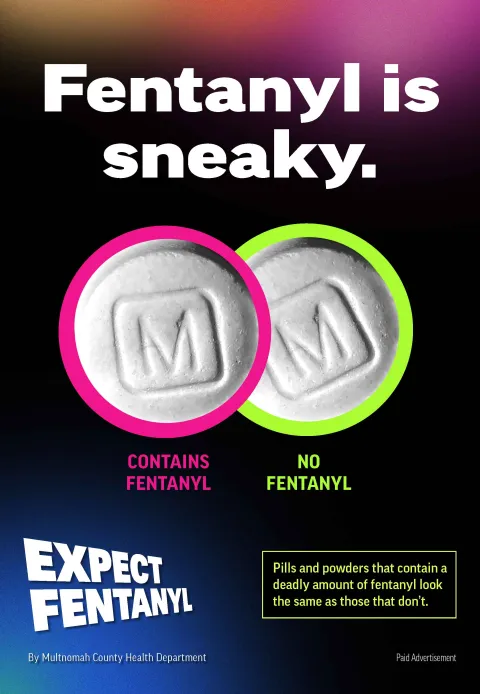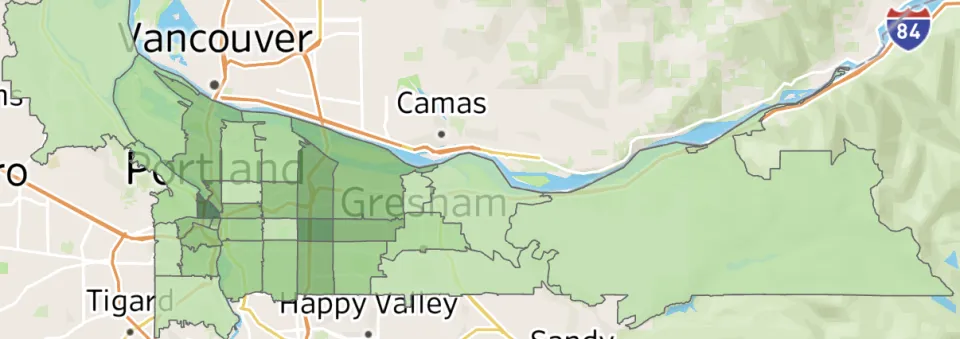
Background
On January 30, 2024, Chair Jessica Vega Pederson, Portland Mayor Ted Wheeler, and Oregon Governor Tina Kotekeach declared a 90-day state of emergency and launched a unified approach to address the fentanyl crisis in Portland’s City Center. The tri-government approach was a first-of-its-kind strategy to better coordinate City, State and County efforts for short term and long term success. The emergency expired April 29, 2024.
Fentanyl-related overdose deaths in Multnomah County have decreased nearly 40% over six months following the end of the 90-day fentanyl emergency declaration - from an average of 52 deaths per month to 32 per month. We’ll continue to monitor these numbers closely as we take actions outlined in our 2024 Overdose Prevention and Response Plan.

Key Accomplishments
- Data sharing: Created dashboards and a map to track fentanyl-related overdoses and deaths, improving data access for agencies and the public.
- Peer outreach expansion: Expanded a successful peer outreach program with law enforcement and addiction services, funded by city, county, and state.
- Naloxone deployment: Rapidly deployed naloxone in the community and shelters to prevent opioid overdoses.
- Community engagement: Held a fentanyl summit with 150+ partners to improve coordination.
- Public awareness: Launched public health education campaigns about the dangers of fentanyl and resources for treatment. Seen on social media and across schools, public transit, and billboards.
- Increased police presence: Expanded police patrols and investigations into fentanyl-related crimes, resulting in increased drug seizures arrests of drug dealers.
- Access to services: Made hundreds of referrals to housing, shelter, sobering & detox, and other treatment programs.
Watch: Governor, Mayor and Chair on Fentanyl Emergency conclusion, next steps
Read the Fentanyl Emergency Final Report
On Friday, May 3 2024, Governor Kotek, Chair Vega Pederson, and Mayor Wheeler released the final report on the joint state of emergency to address the public health and public safety crisis driven by fentanyl in Portland.
The following are specific projects described in the final report:
- Develop an intake facility that accepts referrals from all sources (law enforcement, community organizations, medical professionals, etc.) to match those seeking treatment to the appropriate level of care and supportive services.
- Support the Joint Office of Homeless services to bring a shelter bed tracking system online as soon as possible.
- Improve access to naloxone across high-risk areas and groups.
- Create and support mobile clinics offering Medically Assisted Treatment.
- Continue coordination across jurisdictions with one representative assigned on a coordination team to facilitate discussion among first responders, service providers, related programs and partners.
- Support development of Oregon Health and Science University’s Mission Control real-time addiction treatment bed-tracking system.
- Assure a range of recovery housing options exist to support individuals in different stages of recovery.
- Use data for evaluation and to drive more action.
Fentanyl Emergency Health Dashboards
As part of the 90-Day Fentanyl Emergency, the Health Department released a series of fentanyl dashboards. The data contains information from:
- Multnomah County Medical Examiner's Office
- Fentanyl-related visits to emergency departments and urgent cares
- City of Portland’s Bureau of Emergency Communications
- American Medical Response (AMR) ambulance responses
- Portland Fire & Rescue responses
The data gives us useful information about overdose trends. The data in the dashboard should not be added together. Each dashboard is a different set of data and some of the information overlaps.

View the dashboards
Multnomah County Overdose Map
This map shows suspected and confirmed fatal overdose deaths from fentanyl by geographic area and time. Darker colors show higher counts of fatal fentanyl overdose. You can see the specific number for an area by hovering over it with your computer mouse.

View the map
Participating departments and agencies
- State of Oregon
- Multnomah County
- City of Portland
